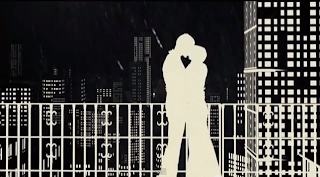The opening scene in this film reveals a man and a woman standing on a balcony in the city.
In the genre, film noir, there are different character roles. The mise-en-scene represents the woman as a 'femme fatale,' she is seen wearing a long red dress, red lipstick, she seems to have light hair and is seen smoking. The red colour connotations suggest danger, which is a characteristic that the femme fatale has aswell as being beautiful and dishonest.
The character roles that feature in film noir films could be classed as genre conventions because specific characters, such as the femme fatale, are a common feature in the films. In this film you see various different examples of femme fatale's, they are shown in the different stories that are being told.
You can hear non-diegetic Jazz music in the background, this is a common convention of the film noir genre because film noir films were originally created in the 40's where Jazz music was popular. The Jazz music is used in this scene to create a 'romantic' atmosphere between the femme fatale and the male protagonist. The jazz music also suggests a happy ending for the two. But this is not the case as later on in the sequence you see him shoot her- resulting in her death.
You hear the male protagonist before you see him in this scene. A voice over is used to narrate what is happening in this scene and it's also used for different characters I'm the film. Voice overs are also a common convention in film noir films and are used to explain a protagonists past and personality. The narration and self-reflection gives a clear idea of the characters ideology and background.
A convention of the comic book genre is seen in the sequence, when they're kissing- the shot becomes black and white and the two become white silhouettes.
Also when the male protagonist shoots the femme fatale you see a slight white flash and the sound is over-exaggerated. When it starts to rain this is both pathetic fallacy and a convention of the comic book genre because the rain drops that create ripples in the puddles are exaggerated.
The camera then zooms out and rotates 360° to reveal the title.
During the character Marv's story you see conventions of the horror genre. Due to the death of his lover,Goldie, Marv seeks revenge on the killer. Marv soon confronts Kevin.
You first see Kevin when the camera pans around Marv who is inspecting something off of the floor, the camera pans around and reveals Kevin standing behind Marv. The low key lighting creates shadows across Kevin's face making his facial features unknown. Having Kevin's face cast in shadow is a convention of the horror genre as his identity is unknown creating a sense of unease within the audience. In horror films there is a character that is demon-like and evil, through the use of mise-en-scene and the way Kevin is shot (technically) suggests he is the demon.
Then it cuts to a close up of Kevin's face, revealing his eyes. The rest of his facial features are still cast in shadow, keeping up with his unknown status. A slight zoom is then used on the face to create tension. A close up is also used to show Kevin's hands, revealing claw-like nails suggesting animal-like behaviour.
Later on in this sequence you see Marv locked up in a basement of an old building, with a window on the wall. The window has bars across it showing Marv's entrapment. Horror conventions can be seen in this room as there is a close up of women's heads mounted upon the wall with blood still around their necks. You later find out that these women have been eaten by Kevin. This could be linked with the close up you see before of his claw-like nails that represent him as an animal. The non-diegetic sound used here creates unease and sickness towards the villain who actually killed Goldie- Kevin.
Later on you see comic book violence of Kevin being eaten by his pet, who he fed the scraps and the bones of the women. A similar technique is used before showing the silhouette of the action in the first scene.
The three genres you see in this film show their conventions through the mise-en-scene, iconic/ similar traits from films before (e.g. voice over narrative and Jazz music) and through the technical aspects. They're used to create representations of characters and to create an impact on the audience.








